Hollow-body guitars have been in the making for way over two centuries. They have been used for playing bebop, jazz, country, rockabilly, punk, metal, and any other genre you can think of.
Despite their broad availability and long tenure in the history of music, they are considered expensive guitars; especially when made by iconic brands.
So, the concept of a cheap semi-hollow guitar or hollow-body guitar is difficult to imagine for most players.
Top 3 - Budget Hollow-body Guitars
Preview | Product | Price |
|---|---|---|
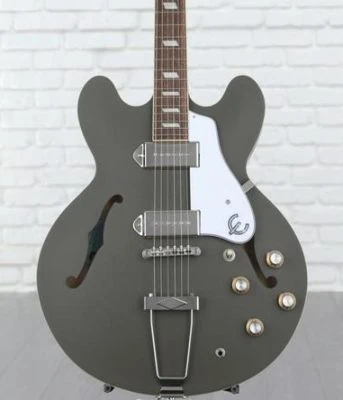 | ||
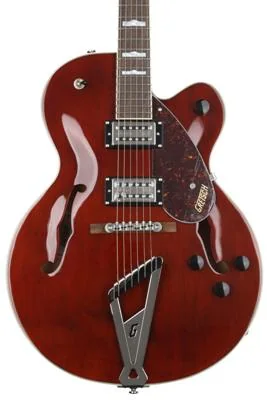 | ||
Well, yours truly went to look for the gems, the pearls under the ocean of cheap rip-offs and faulty guitars to find the cheap hollow-body guitars that can truly take your tone and playing to the next level without breaking the bank.
Get the bow tie and shine those shiny shoes, because it is hollow-body time!
Here we go!
6 Best Budget Hollow-body Guitars for the Money
1. Epiphone Casino
Although not everybody knows this, the Epiphone Casino is a hollow-body guitar. Yes, the Casino departs from Gibson and Epiphone’s long tradition of semi-hollow guitars (like the ES-335) and offers a resonant, full, vibrating body made of laminated maple.
Moreover, in my years playing guitar, I came across Epiphone Casinos on all kinds of stages, from small clubs to full arenas. This guitar is a serious player you can’t beat for the price you pay.
Let me begin by saying that it sports that beautiful C-shaped thin neck that’s just inviting to play for hours at a time. Also, the Indian laurel fingerboard has some of rosewood’s sweetness which makes single-note arpeggios and melodies just beautiful.
In the sound department, the Epiphone PRO P-90 pickups are fierce, biting, and stay clear most of the time.
Perhaps the only caveat with this guitar is that electronics are the Achilles heel of the instrument. For example, volume pots have no fade capabilities, and the tone knob is basically unusable. When you get to 7, you have a huge volume jump, but you can’t just clean up the tone without losing clarity and high-end.
Nevertheless, it’s a hard-to-beat candidate at this price point. I was sitting playing it and enjoying the experience until I ran out of Beatles songs in my head, and everything sounded close to the original.
For the next level, you should disburse an extra $3,000 for the USA version.
2. Gretsch G2420 Streamliner
Gretsch is one of the main hollow-body guitar brands in the world today. Yes, from Chet Atkins to Billy Duffy to the one and only Brian Setzer, Gretsch guitars have been bringing audiences to awe for decades.
This Gretsch G2420 Streamliner belongs to the entry-level tier and is made in China with alternative woods (Nato for the neck and Indian Laurel for the fretboard, with a Maple body) instead of Japan with the real deal. Knowing this, I went to test it hoping to find an instrument that would feedback, buzz, and not stay in tune. Boy, was I surprised.
Indeed, this guitar features a 2.75” hollow-body that allows jazz and rockabilly to co-exist in a single instrument (more on that later). Moreover, the U-shaped neck is fast and comfortable but makes it easy to play cowboy chords too (they got your back, Johnny Cash).
In the sound department, the overwound Broad’Tron pickups do a great job pushing the amplifier into overdrive making it a great rockabilly guitar. The problem with the pickups is that they tend to feedback with the hollow-body and can’t be kept clean enough for jazz while maintaining snap and attack.
I tried some Brian Setzer moves and the guitar responded quite well, but when I moved to some Charlie Christian-approved tones, I found it quite difficult to tame the pickups’ power.
This Gretsch is great if you’re looking for a rocking guitar, for jazzy tones, you might be better off with another option.
3. Grote MG-404
The Grote MG-404 hollow-body guitar is what you would call a clone. Yes, guitars in this price range are a big hit-or-miss. On one hand, you’ll pay less than what a decent pedal is worth, but on the other, you might be buying a project guitar that needs investment to be playable.
Nevertheless, I owe myself to my audience, so I was bold enough to walk into a music store and ask for the cheapest hollow-body guitar available. Let me tell you that it’s a whole different experience from playing a Gretsch or an Epiphone hollow-body guitar.
But, at the same time, it’s also less than half the price those guitars cost.
Let me tell you that my experience wasn’t entirely dreadful. I must admit the fretwork was sloppy and that the guitar tended to go out of tune. Nevertheless, those are things that can easily be fixed by taking the guitar to a technician who can do a professional setup on the instrument.
Indeed, the body showed no signs of faulty glue or lack of accuracy in the binding or the paint job. Also, the fretboard felt smooth and I was able to play some full songs with it before giving it back.
In the sound department, things were not super defined since both pickups sounded muddy, but if you’re not too picky about the original pickup sound or are planning on doing an upgrade, it can do a decent job with most classic jazz tunes.
If you’re an absolute beginner and dig the looks, get one of these as your first instrument and learn the basics with it. For seasoned players, on the other hand, these well-built instruments can easily become a good project guitar with some aftermarket upgrades (tuners, electronics, and pickups).
4. Squier Classic Vibe ‘60s Telecaster Thinline
In the seventies, Fender came up with the Deluxe, Custom, and Thinline Telecasters to compete against dual-humbucker Gibsons. That was in ’72, but three years before, in 1969, the company of the big F introduced this model to the market; the less known one of the thinline Telecasters.
Opposite to what happened in ’72, this ’69 model featured the classic Telecaster pickup combination that gives the semi-hollow-body a high-end you won’t find on any humbucker-equipped guitar. Indeed, the “twang” Teles are famous for is intact but mixed with some low-end from the chambered nato body.
Believe me, I tried some country tunes with this guitar, and it performed just right while adding a welcome bass-oriented groove to the resulting sound.
Perhaps, the only cheap guitar thing I found was that the fret job was far from flawless; on the contrary, some frets (wider than the Mex-made and USA-made reissues) caught the high E string below them.
Other than that, you can play anything with this guitar as long as you don’t need distortion because it tends to feedback generously when you add gain to the equation. If you want the Fender tone with a little more headroom and low end, this guitar is a great candidate.
5. Ibanez Artcore AF75
With a linden body (back, sides, and top) and a nyatoh set-neck with an Indian laurel fingerboard, this hollow-body Ibanez Artcore AF75 is a serious jazz machine.
Let me tell you that, since virtuoso players like Pat Metheny and John Scofield joined the Ibanez line, I have been playing and enjoying their hollow instruments a lot.
Now, this guitar is quite different from the signature models these jazz monsters play. Yes, this is a guitar built entirely with alternative woods, but that respects the traditional archtop design and features a pair of nice-sounding humbucker pickups.
Perhaps, the biggest difference between this guitar and the real deal (that sells for way more) is the definition that real mahogany and rosewood add to the mix.
Plus, maple provides a kind of high-end snap that makes every line sing and is, not absolutely, but partially absent from this instrument. After saying that, let me also say that if you don’t have a highly trained ear, you won’t notice this difference.
This is one great jazz machine for those who are taking their first steps in this long and winding road playing jazz is. Furthermore, if you’re not strictly a jazz player and want a hollow-body guitar to extend the sound palette of your guitar collection, this guitar is a great candidate for a price that won’t break the bank.
6. Epiphone ES-339
Let me begin this review of the Epiphone ES-339 by saying that I was very skeptical before trying it out. Yes, the smaller size always seemed to me as an odd choice by Epiphone and Gibson, but once I held one and started playing it, I realized the mistaken one was always me.
Yes, the fine folks at Gibson came up with a design that challenged everything that came before (the ES-335 dates back to 1959) but they managed to preserve that glass-like tone when playing clean and the low growl of the hollow-body when you add a little dirt to the equation.
Moreover, since it’s a semi-hollow guitar with smaller hollow “wings”, sustain is great and feedback is drastically reduced.
Perhaps, the only thing that was a turn-off for me was the high end of the pickups. Although Epiphone used Alnico PRO pickups, they still have that impossible-to-remove squeal you find in most guitars in this price range. Nevertheless, swapping pickups is a very common practice in any price range.
Let me tell you also that, in the hardware department, the upgrade to Grover tuners is very welcome (I’ve had Epiphone guitars with faulty tuners many times). Finally, the finish and setup of the model I tested was flawless and the instrument was a joy to play.
Cheap Hollow-Body Guitars; Are They Worth Buying?
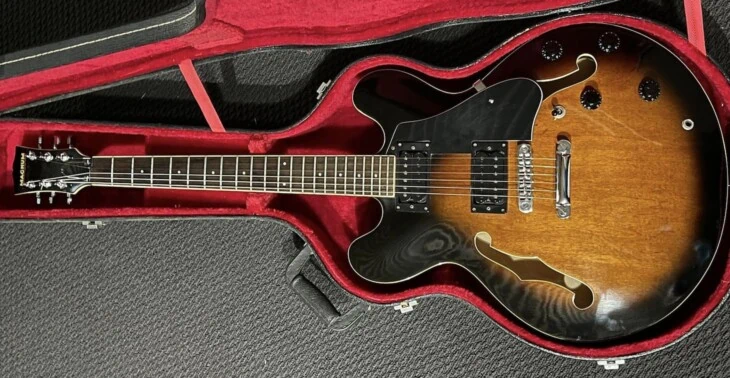
The first question that comes to mind when talking about cheap hollow-body guitars is “Is it worth it to spend little money on a guitar like this or should you wait until you have the money for the real thing?”
Well, let me be the one to bring the good news: It’s not only possible but also recommendable to start your hollow-body adventures with a guitar in this price range. This is because the only way to truly appreciate the wonders of a $3,000+ hollow-body guitar (the next step) is by outgrowing the preceding tier.
Also, let me tell you that if you buy a good guitar in this price range, it might be enough if you’re not a professional or a die-hard jazz enthusiast.
Perhaps, the biggest difference between a guitar in this tier and a more expensive hollow-body guitar is quality variation. By this, I mean that there are more strict quality control measures in higher tiers and you can never play a $3,000+ Gibson or Ibanez or Epiphone or Gretsch that has a twisted neck, a faulty paint job, or piercing frets.
On the other hand, you might find a guitar in this price range that is built flawlessly and that sounds great and another of the same model and even color that sounds and plays terribly.
So, in summary, it is totally worth it to buy a cheap hollow-body guitar to get started in the hollow-body guitar world.
Cutting Corners - Usual Flaws in Cheap Hollow-Body Guitars

Guitars built in the budget niche are usually an amalgamation of quintessential construction techniques and materials (maybe using alternative woods). So, where do companies like Epiphone, Gretsch, or Squier cut corners to come up with competitive prices?
The answer to that question is answered with the things you can expect to be less-than-great in a cheap hollow-body guitar:
Tuners
Tuners are usually generic when it comes to cheap or budget guitars. Although these are paramount for a nice experience playing the instrument (basically keeping it in tune), the big companies tend to save some bucks there.
Pickups
This is another department where you can find generic elements. Indeed, most companies save third-party and expensive pickups for the higher-tier models and usually buy nameless, mass-produced ones for the cheaper models.
Pots / Jacks / Switches
Finally, the electronics (cables, pots, jacks, switches) tend to be less than road-worthy in these guitars and you shouldn’t be surprised if they become loose, stop working, or fall apart soon after you buy your guitar.
To finish this off, let me tell you that, when buying a guitar (even more if it’s a hollow-body instrument), what matters the most is what you can’t replace with aftermarket purchases such as the construction of the body and the neck.
Anybody Said Upgrades?
Tone experiments come at different prices. For example, putting fresh, good strings on a guitar is one of the cheapest ones. But you can take the same idea further and buy aftermarket replacement parts that can transform a cheap guitar into a decent sounding, road-worthy one.
For example, the tuners, pickups, pots, wiring, jacks, and toggle switches can be easily replaced with parts that you’ll find in top-tier guitars costing up to 10 times what you paid for yours.
Don’t be afraid of upgrading your cheap hollow-body guitar until you can afford the real deal.
Cheap Hollow-Body Guitars Red Flags
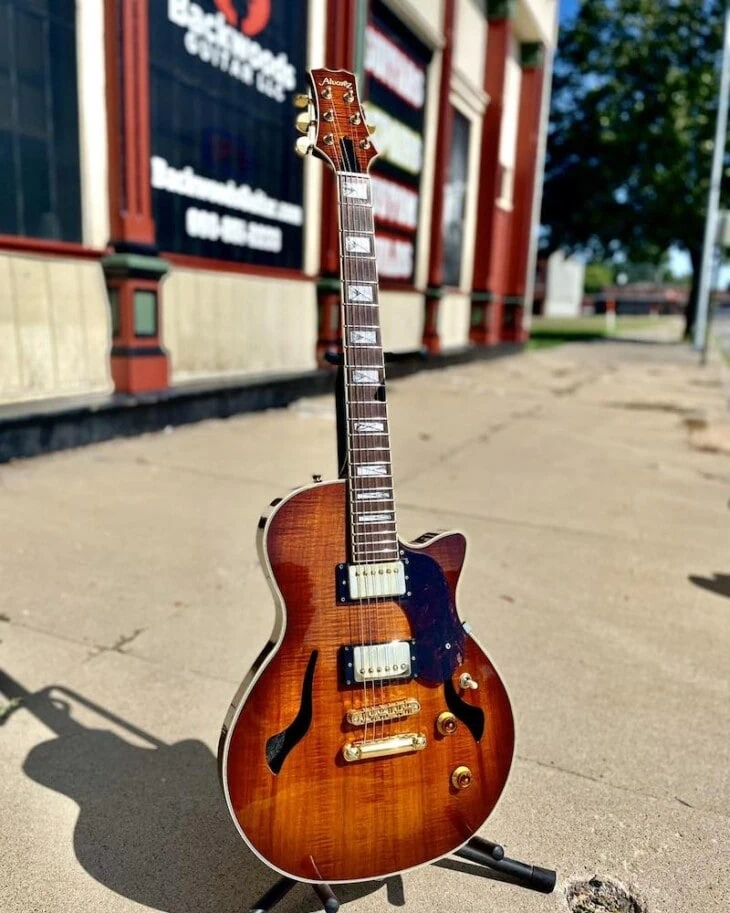
Although most faulty parts can be replaced, these are examples of the kind of things you should walk away from when purchasing cheap hollow-body guitars:
Piercing Frets
Frets can be replaced but it’s not the cheapest tone experiment at all and you need a professional to do it for you. So, if you find piercing frets in your guitar, you can ask for a different instrument in the same model and color. Plus, it can be a sign of a twisted, faulty neck.
Twisted Necks
This is a big, BIG no-no when it comes to choosing a guitar. There’s very little to do when you have a twisted neck.
One of the reasons this might happen is that wood is not stationed for enough time to dry completely and continues to move even after being put in position. You’ll realize this because you can’t keep the guitar in tune, and it can’t be set up properly.
Faulty Body Work
Hollow-body guitars require a special construction technique in which the different parts of the guitar body are bent to shape and then glued together with the arched top before the neck is glued in.
If this process is not properly done, you might find little spaces between the binding and the body, for example. Look for those before you buy, to repair that is to make a structural change on the guitar.
Watch Out for Feedback, A Word of Warning
Before finishing up this section, let me tell you that not every musical style will benefit from a hollow-body guitar. Except if you’re Billy Duffy, who’s been rocking a hollow-body guitar with the almighty The Cult for decades, beware of distortion and feedback (he explains it in the video below).
The man himself stuffs his guitar with a cloth to avoid the screaming feedback, but if you’re on a small stage and must be close to your amp, there’s not much you can do to shut the feedback up.
The Bottom End
Buying a hollow-body guitar under $500 means buying a guitar that will not be perfect but that can be overhauled with a very small investment.
Furthermore, some of the guitars on this list can be lifelong companions if you take good care of them and don’t have too much of an exquisite ear for nuances and details.
Happy (hollow-body) playing!

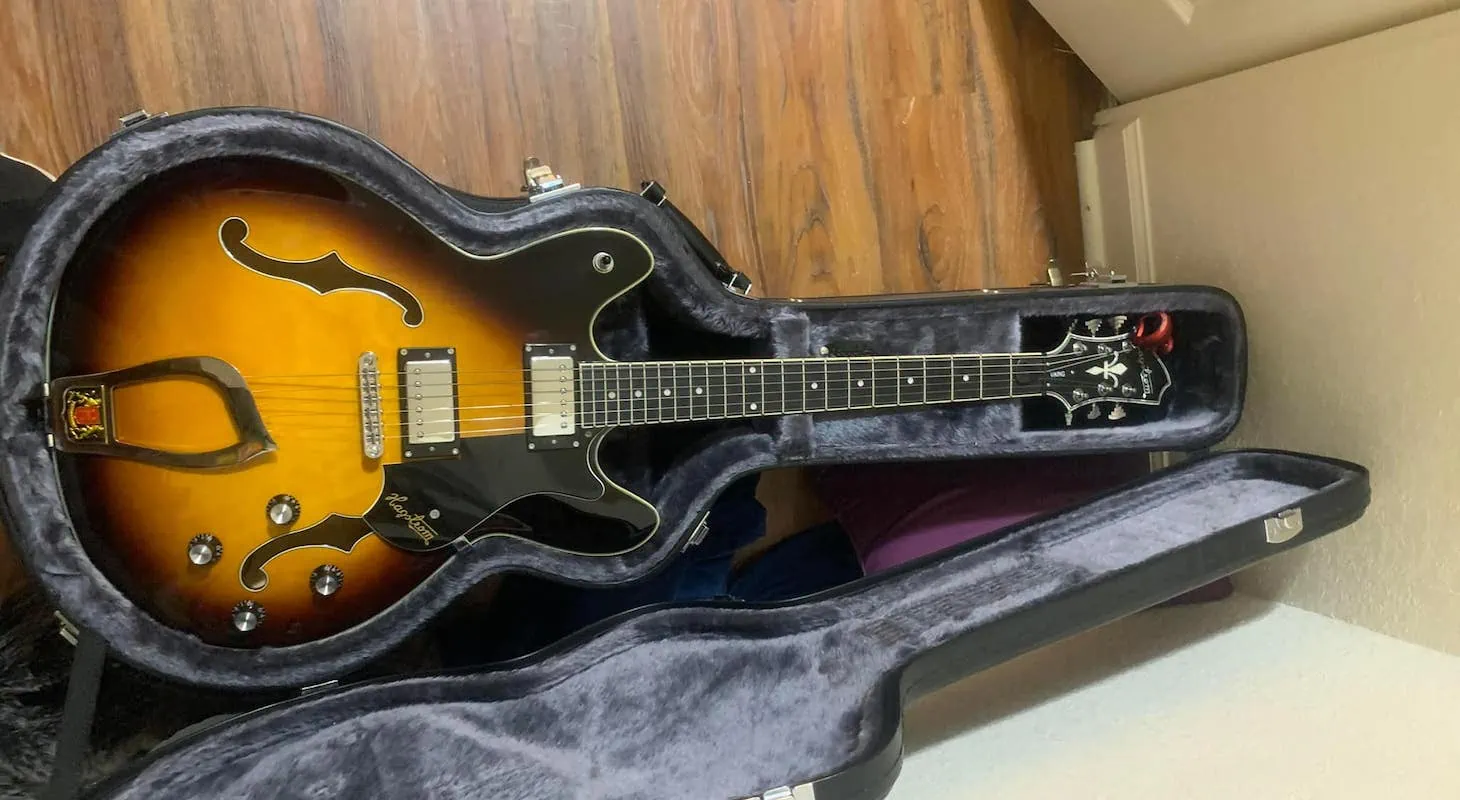
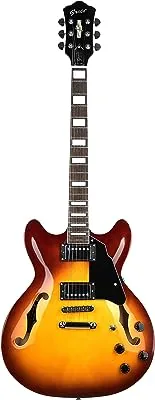
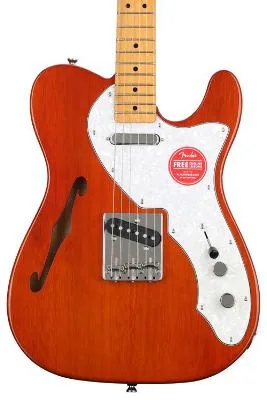
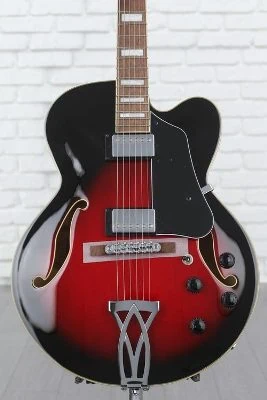
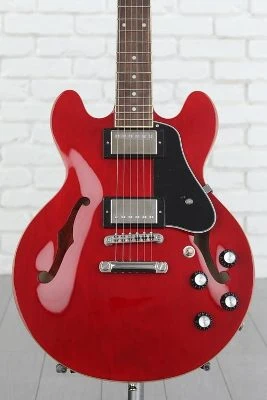
Having owned many guitars over 40 years I have to say the Grote was the biggest surprise I’ve ever purchased. Punches well above it’s weight class as far as feel and playability goes. After a proper setup and better strings it’s comparable to my $1k instruments. Much better than any Epi I’ve ever owned that’s for sure.
Good article! Maybe another one on the next tier up…….e.g.What about Peerless guitars?
Good article, but would you please elaborate on what “alternative woods” are?
That is, rather than maple, are we dealing with basswood, birch, or that cardboardy stuff they make hollow core doors out of?
Or something totally different…
Hi Alan, the neck is Nato, while the fingerboard is Indian Laurel. But the body wood is still Maple (unchanged).